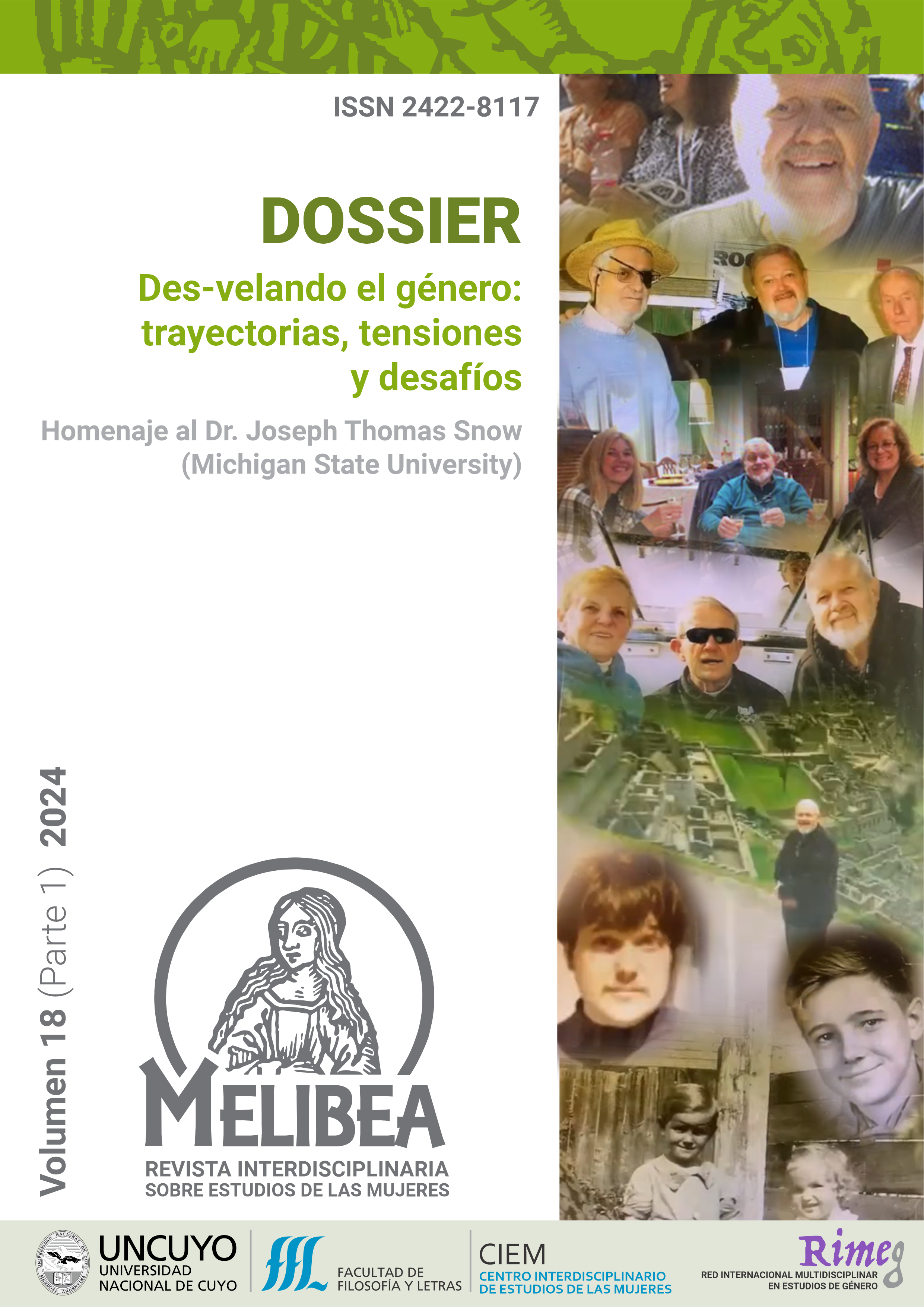Enfermedades y muerte en mujeres del mundo helenístico en cuatro epigramas de los siglos II-I a. C.
Palabras clave:
Enfermedades, Muerte, Mujeres, Helenismo, EpigramasResumen
El presente artículo se focaliza en las manifestaciones de enfermedades en mujeres y sus consecuentes muertes, a través de cuatro epigramas funerarios, datados en el mundo helenístico entre los siglos II y I a. C. Estos reflejan aspectos de la vida cotidiana que, en este caso, aluden a decesos femeninos ocasionados por enfermedades, un fenómeno muy frecuente en la Antigüedad. Para ello, se han seleccionado cuatro epigramas procedentes de distintos puntos geográficos del mundo helenístico, aunque registrados en las mismas centurias: Corinto (ca. II-I a. C., epigrama 352, GV 2020), Alejandría (I a. C., 136, GV 1875), Cirene (ca. II-I a. C., 226, GV 758) y Renea (I a. C., 205, GV 1005). En primer lugar, se procederá a la traducción1 de la fuente original griega; luego, se elaborará una aproximación a la reconstrucción del contexto histórico y de la vida cotidiana del cual provienen, rescatando la información que brindan acerca de las mujeres fallecidas por enfermedades: nombres personales, origen, franja etaria, condición social, situación familiar, motivo de deceso, condiciones sanitarias, invocación a los dioses, entre otras cualidades. Los roles de género, según el contexto histórico y sociocultural helenístico evidenciado en los poemas examinados, advierten la impronta de aquellos tiempos.
Citas
Del Barrio Vega, M. L. (Trad.). (2016). Epigramas funerarios griegos. Gredos.
Fernández Galiano, M. (Trad.). (1978). Antología Palatina. Epigramas helenísticos. Gredos.
Kaibel, G. (1878). Epigrammata Graeca ex lapidibus conlecta. Apud G. Reimer. Paton, W. R. (Ed.). (1956-1958). The Greek Anthology (vol. I). Harvard University Press.
Peek, W. (1955). Griechische Vers-Inschriften. Grab-epigramme / Greek Verse Inscriptions. Epigrams on funerary stelae and monuments. Ares Publishers.
Referencias bibliográficas generales
A Greek-English Lexicon. Liddell and Scott. Perseus Digital Library (Perseus Project). https://www.perseus.tufts.edu/hopper/text?doc=Perseus:text:1999.04.0057:entry=lo/gos
Arrigoni, G. (Ed.). (1985). Le donne in Grecia. Laterza.
Berti, R. (1996). L' Epigramma Greco: Un percorso didattico. Figure femminili. Università degli studi di Bologna.
Cantarella, E. (2013). L'ambiguo malanno: Condizione e immagine della donna nell’antichità greca e romana. Feltrinelli Editore.
Colosimo, N. M. (2017). Reconstructing the Dedicatory Experience: Flexibility and Limitation in the Ancient Greek Dedicatory Process [Tesis Doctoral en Filosofía]. Departamento de Arqueología Clásica y del Cercano Oriente, Bryn Mawr College. https://www.proquest.com/openview/2a8df29533f45d3b7394aaa7bfcf1922/1?pq-origsite=gscholar&cbl=18750
Difabio, E. H. et al. (2013). La mesura y la desmesura en epigramas de la Antología Palatina. EDIUNC.
Grossman, J. B. (2002). Greek funerary sculpture: catalogue of the collections at the Getty Villa. Getty Publications.
Pomeroy, S. B. (1997). Families in Classical and Hellenistic Greece: representations and realities. Oxford University Press.
Sánchez Ortiz de Landaluce, O. (2009). Elementos míticos en el epigrama inscripcional, Estudios de epigrafía griega, 205-218. https://www.academia.edu/1208110/Elementos_m%C3%ADticos_en_el_epigrama_ inscripcional
Velasco Abellán, F. P. D. (1995). Los caminos de la muerte: religión, rito e iconografía del paso al más allá en la Grecia antigua. Trotta. https://www.academia.edu/6131923/Los_caminos_de_la_muerte_religi%C3%B3n_rito_e_iconograf%C3%ADa_del_paso_del_m%C3%A1s_all%C3%A1_en_la_Grecia_antigua
Vermeule, E. (1981). Aspects of death in early Greek art and poetry. University of California Press.
Referencias bibliográficas específicas
Alganza Roldán, M. (1990). La mujer en la historiografía griega helenística: Polibio, mujeres e historia viril. La mujer en el mundo Mediterráneo Antiguo, 53-72, Universidad de Granada. https://www.academia.edu/4639997/La_mujer_en_la_historiograf%C3%ADa_griega_helen%C3%ADstica_Polibio_mujeres_e_historia_viril
Cabrera, J. P. (1992). Consideraciones sobre la mujer en el epigrama funerario helenístico de la Antología Palatina. Fortunatae, 4, 183-191. https://dialnet.unirioja.es/descarga/articulo/163866.pdf
De Lezica, N. B. (2002). La figura de la mujer en tres epigramatistas del período helenístico: Calímaco, Asclepíades de Samos y Leónidas de Tarento. Stylos, 11, 27-40. https://repositorio.uca.edu.ar/bitstream/123456789/11478/1/figura-mujer-epimagramistas.pdf
Difabio, E. H. (2020). La peste igualadora: Epigrama 241 de Antípatro de Sidón en Antología Palatina 7. Revista de Literaturas Modernas, 50(1), 43-54. https://revistas.uncu.edu.ar/ojs3/index.php/literaturasmodernas/article/view/3464/2829
González Galván, M. G. (2003). Estudio sobre la mujer en la poesía helenística [Tesis Doctoral]. Departamento de Filología Clásica y Árabe, Universidad de la Laguna. https://riull.ull.es/xmlui/handle/915/9954
Martínez Fernández, A. (1992). La mujer en los epitafios métricos de Creta de época helenística. Fortunatae: Revista canaria de Filología, Cultura y Humanidades Clásicas, 4, 119-150. https://dialnet.unirioja.es/descarga/articulo/163869.pdf
Martínez Fernández, A. (2001). Notas sobre la imagen de la mujer en los epigramas griegos de época helenística. Revista de Filología de la Universidad de La Laguna, 19, 219-228. https://riull.ull.es/xmlui/handle/915/21785
Mirón Pérez, M. D. (1998). Cómo convertirse en diosa: Mujeres y divinidad en la Antigüedad Clásica. Arenal. Revista de historia de las mujeres, 5(1), 23-46. https://dialnet.unirioja.es/descarga/articulo/8252644.pdf
Mirón Pérez, M. D. (2021). Virtudes domésticas/acciones públicas. Las reinas atálidas y las transformaciones de la feminidad helenística. Asparkía. Investigación feminista, 39, 83-101. https://dialnet.unirioja.es/descarga/articulo/8180146.pdf
Descargas
Publicado
Cómo citar
Número
Sección
Licencia

Esta obra está bajo una licencia internacional Creative Commons Atribución-NoComercial 4.0.
Esta obra está bajo una Licencia Creative Commons Atribución-NoComercial 4.0 Internacional.
Los/as autores/as que publican en esta revista están de acuerdo con los siguientes términos:
1. Los/as autores conservan los derechos de autor y garantizan a la revista el derecho de ser la primera publicaci´´ón del trabajo bajo una licencia Creative Commons Atribución-NoComercial 4.0 Internacional. Por esto pueden compartir el trabajo con la referencia explícita de la publicación original en esta revista.
2. Revista Melibea permite y anima a los autores a difundir la publicación realizada electrónicamente, a través de su enlace y/o de la versión postprint del archivo descargado de forma independiente.
















